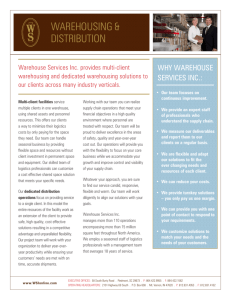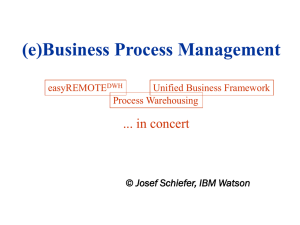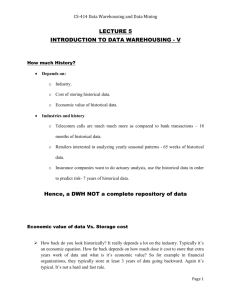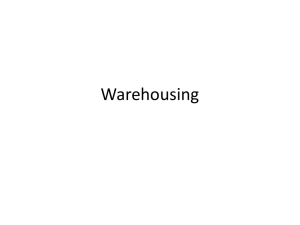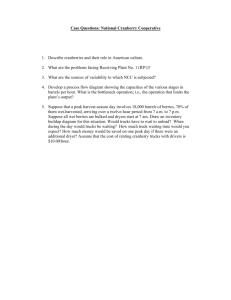Final Examination Semester 1/ Year 2009
advertisement
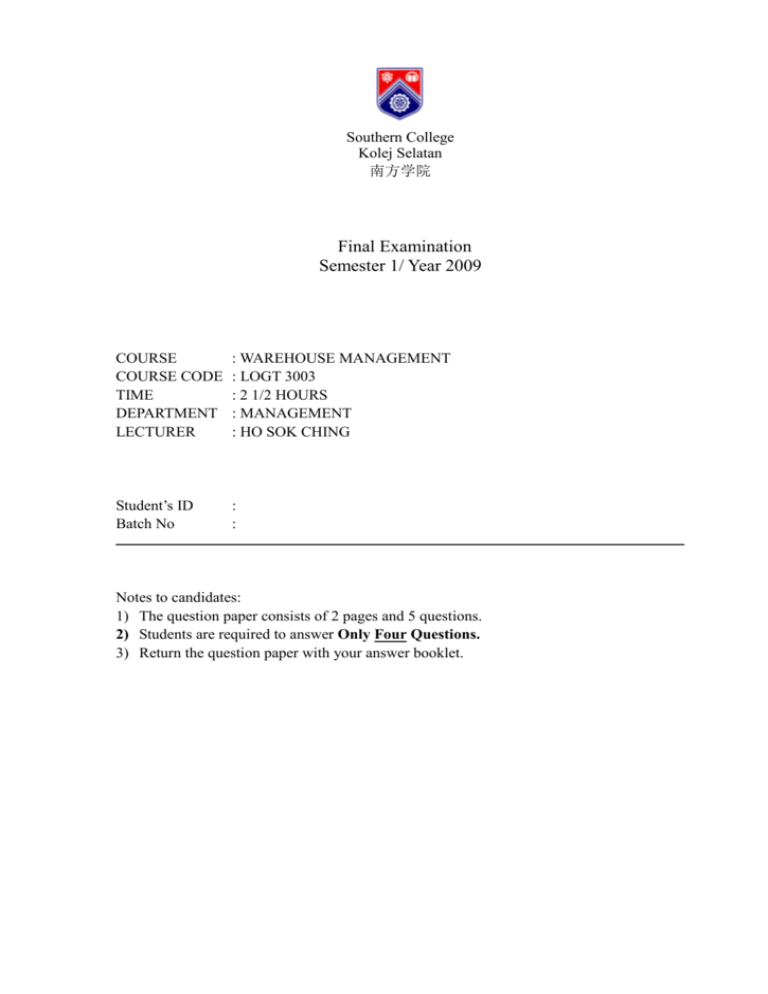
Southern College Kolej Selatan 南方学院 Final Examination Semester 1/ Year 2009 COURSE COURSE CODE TIME DEPARTMENT LECTURER : WAREHOUSE MANAGEMENT : LOGT 3003 : 2 1/2 HOURS : MANAGEMENT : HO SOK CHING Student’s ID Batch No : : Notes to candidates: 1) The question paper consists of 2 pages and 5 questions. 2) Students are required to answer Only Four Questions. 3) Return the question paper with your answer booklet. Warehouse Management Q1 (a) Describe the advantages and disadvantages of private warehousing? (10 marks) (b) Discuss on why contract warehousing is becoming a preferred alternative for many organizations. (15 marks) Q2 (a) What is a warehouse management system (WMS)? Explain. (5 marks) (b) Discuss, how can WMS be beneficial to warehousing operations? (10 marks) (c) What is OSHA? What is the role of OSHA in warehousing safety? (10 marks) Q3 Explain the following terms: (5 x 5 = 25 marks) (a) Presence synergies, (b) Industry synergies, (c) Operating flexibility, (d) Location flexibility, (e) Scale economies. 1/ 2 Warehouse Management Q4 List and discuss any 5 service benefits to be achieved through warehousing activities. (25 marks) Q5 Explain the following terms: (a) (b) (c) (d) (e) Counter-balance trucks (CBTs) Narrow aisle trucks (NATs) Hand pallet trucks (HPTs) Multi-level riser picking trucks (MRPTs) Articulated fort-lift trucks (AFTs) ___________000_________ 2/2 (5 x 5 = 25 marks) Southern College Kolej Selatan 南方学院 Marking Scheme Final Examination Semester 1/ Year 2009 COURSE COURSE CODE TIME DEPARTMENT LECTURER : WAREHOUSE MANAGEMENT : LOGT 3003 : 2 1/2 HOURS : MANAGEMENT : HO SOK CHING Warehouse Management Q1 (a) Describe the advantages and disadvantages of private warehousing? (10 marks) One disadvantage to private warehousing is that they are characterized by high fixed costs—which necessitates high and steady demand volumes. In addition, a high fixed cost alternative becomes less attractive in times of high interest rates because it is more costly to secure the necessary financing. Private warehousing may also reduce an organization’s flexibility with respect to responding to changes in the external environment. As for advantages, private warehousing offers users a great deal of control over their storage needs. More specifically, private warehouses can be constructed to meet user specifications and companies can also control product placement within a facility. In addition, private warehousing offers access to products when an organization needs or wants them. (b) Discuss on why contract warehousing is becoming a preferred alternative for many organizations. (15 marks) Contract warehousing simultaneously mitigates the negative aspects and accentuates the positive aspects of public and private warehousing. For instance, contract warehousing allows a company to focus on its core competencies, with warehousing management provided by experts. Contract warehousing also tends to be more cost effective than private warehousing, with potentially the same degree of control because key specifications can be included in the relevant contract. 1/5 Warehouse Management Q2 (a) What is a warehouse management system (WMS)? Explain. (b) Discuss, how can WMS be beneficial to warehousing operations? (5 marks) (10 marks) Warehouse management systems are software packages that control the movement and storage of materials within an operation. Activities that can be controlled by WMS include inventory management, product receiving, and determination of storage locations, order selection processes, and order shipping. Data entry errors can be dramatically reduced and the travel times for order picking can be reduced by nearly 50%. Other benefits to WMS include reduced operating expenses, fewer stock-outs, increased inventory accuracy, and improved service to customers. (c) What is OSHA? What is the role of OSHA in warehousing safety? (10 marks) OSHA is the Occupational Safety and Health Administration, an agency of the U.S. federal government that has responsibilities for industrial safety practices. In recent years, OSHA mandated that forklift drivers actually have to drive forklifts as part of the training process and that driver performance be evaluated every three years. OSHA inspectors make frequent visits to industrial workplaces. In cases of non-compliance, citations can be issued and fines can be levied. 2/5 Warehouse Management Q3 Explain the following terms: (5 x 5 = 25 marks) (a) Presence synergies, (b) Industry synergies, (c) Operating flexibility, (d) Location flexibility, (e) Scale economies. • • • • • Presence synergies refer to the marketing benefits of having inventory located nearby in a building that is clearly affiliated with the enterprise (e.g., the building has the firm's name on the door). It is widely thought that customers are more comfortable when suppliers maintain inventory in nearby locations. Industry synergies refer to the operating benefits of collocating with other firms serving the same industry. Operating flexibility refers to the ability to adjust internal policies and procedures to meet product and customer needs. Location flexibility refers to the ability to quickly adjust warehouse location and number in accordance with seasonal or permanent demand changes. Scale economies refer to the ability to reduce material-handling and storage through application of advanced technologies. 3/5 Warehouse Management Q4 List and discuss any 5 service benefits to be achieved through warehousing activities. (25 marks) • Five basic service benefits are achieved through warehousing: – Spot stock. Under spot stocking, a selected amount of a firm's product line is placed or "spot stocked" in a warehouse to fill customer orders during a critical marketing period. In particular, manufacturers with limited or highly seasonal product lines are partial to this service. Utilizing warehouse facilities for stock spotting allows inventories to be placed in a variety of markets adjacent to key customers just prior to a maximum period of seasonal sales. – Assortment. An assortment warehouse stocks product combinations in anticipation of customer orders. The assortments may represent multiple products from different manufacturers or special assortments as specified by customers. – Mixing. In a typical mixing situation, truckloads of products are shipped from manufacturing plants to warehouses. Each large shipment enjoys the lowest possible transportation rate. Upon arrival at the mixing warehouse, factory shipments are unloaded and the desired combination of each product for each customer or market is selected. – Production support. Production support warehousing provides a steady supply of components and materials to assembly plants. Safety stocks on items purchased from outside vendors may be justified because of long lead times or significant variations in usage. The operation of a production support warehouse is to supply or "feed" processed materials, components, and subassemblies into the assembly plant in an economic and timely manner. – Market presence. While a market presence benefit may not be so obvious, it is often cited by marketing managers as a major advantage of local warehouses. The market presence factor is based on the perception or belief that local warehouses can be more responsive to customer needs and offer quicker delivery than more distant warehouses. 4/5 Warehouse Management Q5 Explain the following terms: (a) Counter-balance trucks (CBTs) (b) Narrow aisle trucks (NATs) (c) Hand pallet trucks (HPTs) (d) Multi-level riser picking trucks (MRPTs) (e) Articulated fort-lift trucks (AFTs) • • • • • (5 x 5 = 25 marks) Counter-balance trucks (Fuel) (CBTs) are the most common type of fort-lift truck, wide turning circle is compulsory so wide aisle widths is needed. Narrow aisle trucks (NATs) operate in very narrow aisles using battery power. 2 types- Swing mast trucks (swing through 90 degrees in one direction only). Turret trucks , 90 degrees in either direction. These types of trucks operate required a guidance system (side aisle rails or guidance buried in the floor) in view of the tight tolerance levels while they are operating in the racking. Hand pallet trucks (HPTs) or pallet jacks, no lofting capacity. Multi-level riser picking trucks (MRPTs) or man-up trucks are used in order selection and are specially designed for manual picking at varied levels of pallet racking. Like NAT without a swinging or turning mast. Articulated fort-lift trucks (AFTs) or bendy trucks are a hybrid combining CBT/NAT application, powered by battery or LPG. ________000_______ 5/5
